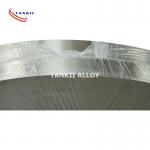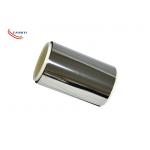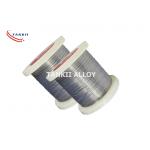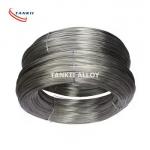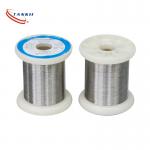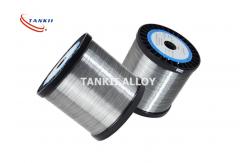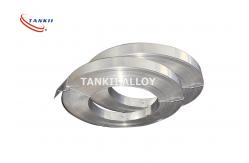TANKII Ni80cr20 Electric/Electrical/Heating/Resistance/Furnace
Nichrome 8020 Nickel Chrome Alloy Wire The material NiCr8020 with the material number 2.4869 is applied in
the form of strips, sheets, tubes and wires for furnace
construction components and heating conductors.
It is a nickel-chromium heating conductor alloy for operating
temperatures of up to 1150 °C and often contains additives of rare
earths for a higher resistance to oxidation, especially with
frequent switching operations or broad temperature variations.
The resistance to atmospheric corrosion at 20 °C is high up to the
upper operating temperature the resistance to air and other
oxygen-containing gases as well as to nitrogen-containing
low-oxygen gases is high as well, yet it is low to oxidizing as
well as reducing gases containing sulphur.
The resistance to carbonizing is high. Application for industrial
electric furnaces, enamelling furnaces, household appliances,
night-current storage space-heaters. | Chemical Composition and Propertes: | | | Propertes/Grade | NiCr 80/20 | NiCr 70/30 | NiCr 60/15 | | | Main Chemical Composition(%) | Ni | Bal. | Bal. | 55.0-61.0 | | | Cr | 20.0-23.0 | 28.0-31.0 | 15.0-18.0 | | | Fe | ≤ 1.0 | ≤ 1.0 | Bal. | | | Max Working Temperature(ºC) | 1200 | 1250 | 1150 | | | Resistivity at 20ºC(μ Ω · m) | 1.09 | 1.18 | 1.12 | | | Density(g/cm3) | 8.4 | 8.1 | 8.2 | | | Thermal Conductivity(KJ/m· h· ºC) | 60.3 | 45.2 | 45.2 | | | Coefficient of Thermal Expansion(α × 10-6/ºC) | 18 | 17 | 17 | | | Melting Point(ºC) | 1400 | 1380 | 1390 | | | Elongation(%) | > 20 | > 20 | > 20 | | | Micrographic Structure | austenite | austenite | austenite | | | Magnetic Property | nonmagnetic | nonmagnetic | nonmagnetic | | | | | | | | | | Propertes/Grade | NiCr 35/20 | NiCr 30/20 | Karma | Evanohm | | Main Chemical | Ni | 34.0-37.0 | 30.0-34.0 | Bal | Bal | | Composition(%) | Cr | 18.0-21.0 | 18.0-21.0 | 19.0-21.5 | 19.0-21.5 | | | Fe | Bal. | Bal. | 2.0-3.0 | - | | Max Working Temperature(ºC) | 1100 | 1100 | 300 | 1400 | | Resistivity at 20ºC | 1.04 | 1.04 | 1.33 | 1.33 | | (μ Ω · m) | | Density(g/cm3) | 7.9 | 7.9 | 8.1 | 8.1 | | Thermal Conductivity | 43.8 | 43.8 | 46 | 46 | | (KJ/m· h· ºC) | | Coefficient of Thermal | 19 | 19 | - | - | | Expansion(α × 10-6/ºC) | | Melting Point(ºC) | 1390 | 1390 | 1400 | 1400 | | Elongation(%) | > 20 | > 20 | > 20 | > 20 | | Micrographic Structure | austenite | austenite | austenite | austenite | | Magnetic Property | nonmagnetic | nonmagnetic | nonmagnetic | nonmagnetic |
Typical Mechanical properties(1.0mm)
- Elongation: 30%
- Yield Strength: 420Mpa
- Tensile Strength: 810Mpa
| Chemical Composition | Nickel 80%, Chrome 20% | | Condition | Bright/Acid white/Oxidied Color | | Diameter | 0.018mm~1.6mm in spool, 1.5mm-8mm packing in coil, 8~60mm in rod | | Nichrome Round Wire | Diameter 0.018mm~10mm | | Nichrome Ribbon | Width 5~0.5mm, thickness 0.01-2mm | | Nichrome Strip | Width 450mm~1mm, thickness 0.001m~7mm | | Diameter | 1.5mm-8mm packing in coil, 8~60mm in rod | | Grade | Ni80Cr20, Ni70/30, Ni60Cr15, Ni60Cr23, Ni35Cr20Fe, | | Ni30Cr20 Ni80, Ni70,Ni60, Ni40, | | Advantage | The metallurgical structure of nichrome | | confers them a very good plasticity when cold. | | Characteristics | Stable performance; Anti-oxidation; Corrosion resistance; | | High temperature stability; Excellent coilforming ability; | | Uniform and beautiful surface condition without spots. | | Usage | Resistance heating elements;Material in metallurgy, | | Household appliances;Mechanical manufacturing and | | other industries. |
Mine trolley brake resistor:
|
